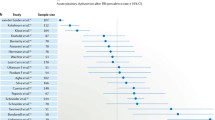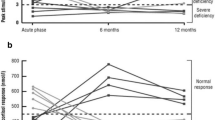Abstract
TBI is one of the most important public health problems in the world. Although the relationship between TBI and hypopituitarism has been known for a long time, neuroendocrine changes were investigated in detail recently. The prevalence of neuroendocrine abnormalities in patients with TBI is very high. Gonadotropin and GH deficiencies appear to be the most common defects. Although combative sports are very popular around the world, trauma due to sports is not generally considered as a cause of TBI in most of the epidemiological studies. All the studies regarding TBI in sports published so far in the literature based on neuropshycological or radiological assessment and no neuroendocrine changes were investigated. In a recent study, pituitary functions in amateur boxers have been investigated and it has been reported that boxing is a cause of TBI and isolated GH deficiency is very common among amateur boxers. It seems that acute or chronic head trauma in sports is a possible cause of hypopituitarism. In this review, current data regarding TBI in sports are discussed.
Similar content being viewed by others
References
Bruns J Jr, Hauser WA. The epidemiology of traumatic brain injury: a review. Epilepsia 2003;10:2–10.
Whitman S, Coonley-Hoganson R, Desai BT. Comparative head trauma experiences in two socioeconomically different Chicago-area communities: a population study. Am J Epidemiol 1984;119:570–580.
Lieberman SA, Oberoi AL, Gilkison CR, Masel BE, Urban RJ. Prevalence of neuroendocrine dysfunction in patients recovering from traumatic brain injury. J Clin Endocrinol Metab 2001;86:2752–2756.
Aimaretti G, Ambrosio MR, Di Somma C, et al. Traumatic brain injury and subarachnoid haemorrhage are conditions at high risk for hypopituitarism: screening study at 3 months after the brain injury. Clin Endocrinol (Oxf) 2004;61:320–326.
Bondanelli M, Ambrosio MR, Zatelli MC, De Marinis L, Uberti EC. Hypopituitarism after traumatic brain injury. Eur J Endocrinol 2005;152:679–691.
Casanueva FF, Leal A, Koltowska-Haggstrom M, Jonsson P, Goth MI. Traumatic brain injury as a relevant cause of growth hormone deficiency in adults: A KIMS-based study. Arch Phys Med Rehabil 2005;86:463–468.
Boughey JC, Yost MJ, Bynoe RP. Diabetes insipidus in the head-injured patient. Am Surg 2004;70:500–503.
Iglesias P, Gomez-Pan A, Diez JJ. Spontaneous recovery from post-traumatic hypopituitarism. J Endocrinol Invest 1996;19:320–323.
Kaufman HH, Timberlake G, Voelker J, Pait TG. Medical complications of head injury. Med Clin North Am 1993;77:43–60.
Agha A, Sherlock M, Phillips J, Tormey W, Thompson CJ. The natural history of post-traumatic neurohypophysial dysfunction. Eur J Endocrinol 2005;152:371–377.
Kelly DF, Gonzalo IT, Cohan P, Berman N, Swerdloff R, Wang C. Hypopituitarism following traumatic brain injury and aneurysmal subarachnoid hemorrhage: a preliminary report. J Neurosurg 2000;93:743–752.
Daniel PM, Prichard MM, Treip CS. Traumatic infarction of the anterior lobe of the pituitary gland. Lancet 1959;2:927–931.
Kornblum RN, Fisher RS. Pituitary lesions in craniocerebral injuries. Arch Pathol 1969;88:242–248.
Ceballos R. Pituitary changes in head trauma (analysis of 102 consecutive cases of head injury). Ala J Med Sci 1966;3:185–198.
Crompton MR. Hypothalamic lesions following closed head injury. Brain 1971;94:165–172.
Consensus conference. Rehabilitation of persons with traumatic brain injury. NIH consensus development panel on rehabilitation of persons with traumatic brain injury. JAMA 1999;282:974–983.
Rabadi MH, Jordan BD. The cumulative effect of repetitive concussion in sports. Clin J Sport Med 2001;11:194–198.
Powell JW. Cerebral concussion: causes, effects, and risks in sports. J Athl Train 2001;36:307–311.
Jantzen KJ, Anderson B, Steinberg FL, Kelso JA. A prospective functional MR imaging study of mild traumatic brain injury in college football players. AJNR Am J Neuroradiol 2004;25:738–745.
Delaney JS, Lacroix VJ, Leclerc S, Johnston KM. Concussions among university football and soccer players. Clin J Sport Med 2002;12:331–338.
Matser JT, Kessels AG, Jordan BD, Lezak MD, Troost J. Chronic traumatic brain injury in professional soccer players. Neurology 1998;51:791–796.
Naunheim RS, Standeven J, Richter C, Lewis LM. Comparison of impact data in hockey, football, and soccer. J Trauma 2000;48:938–941.
Uzura M, Taguchi Y, Matsuzawa M, Watanabe H, Chiba S. Chronic subdural haematoma after snowboard head injury. Br J Sports Med 2003;37:82–83.
Prall JA, Winston KR, Brennan R. Severe snowboarding injuries. Injury 1995;26:539–542.
Ryan AJ. Intracranial injuries resulting from boxing. Clin Sports Med 1998;17:155–168.
Miele VJ, Carson L, Carr A, Bailes JE. Acute on chronic subdural hematoma in a female boxer: a case report. Med Sci Sports Exerc 2004;36:1852–1855.
Jordan BD. Chronic traumatic brain injury associated with boxing. Semin Neurol 2000;20:179–185.
Zhang L, Ravdin LD, Relkin N, et al. Increased diffusion in the brain of professional boxers: a preclinical sign of traumatic brain injury? AJNR Am J Neuroradiol 2003;24:52–57.
Jordan BD, Relkin NR, Ravdin LD, Jacobs AR, Bennett A, Gandy S. Apolipoprotein E epsilon4 associated with chronic traumatic brain injury in boxing. JAMA 1997;278:136–140.
Jordan BD, Jahre C, Hauser WA, et al. CT of 338 active professional boxers. Radiology 1992;185:509–512.
McCrory P. Cavum septi pellucidi—a reason to ban boxers? Br J Sports Med 2002;36:157–161.
Casson IR, Sham R, Campbell EA, Tarlau M, Didomenico A. Neurological and CT evaluation of knocked-out boxers. J Neurol Neurosurg Psychiatry 1982;45:170–174.
Ohhashi G, Tani S, Murakami S, Kamio M, Abe T, Ohtuki J. Problems in health management of professional boxers in Japan. Br J Sports Med 2002;36:346–352.
Butler RJ. Neuropsychological investigation of amateur boxers. Br J Sports Med 1994;28:187–190.
Posttraumatic dementia in Alzheimer's disease. In: Jatzman R, Terry RD, Bick K (eds.) Senile Dementia and Related Disorders. New York: Raven Press, 1978:125–133.
Corsellis JA, Bruton CJ, Freeman-Browne D. The aftermath of boxing. Psychol Med 1973;3:270–303.
Kelestimur F, Tanriverdi F, Atmaca H, Unluhizarci K, Selcuklu A, Casanueva FF. Boxing as a sport activity associated with isolated GH deficiency. J Endocrinol Invest 2004;27:RC28–RC32.
Kelestimur F. Sheehan's syndrome. Pituitary 2003;6:181–188.
McCrory P. Should we treat concussion pharmacologically? The need for evidence based pharmacological treatment for the concussed athlete. Br J Sports Med 2002;36:3–5.
Author information
Authors and Affiliations
Corresponding author
Rights and permissions
About this article
Cite this article
Keleştimur, F. Chronic Trauma in Sports as a Cause of Hypopituitarism. Pituitary 8, 259–262 (2005). https://doi.org/10.1007/s11102-006-6051-3
Published:
Issue Date:
DOI: https://doi.org/10.1007/s11102-006-6051-3




